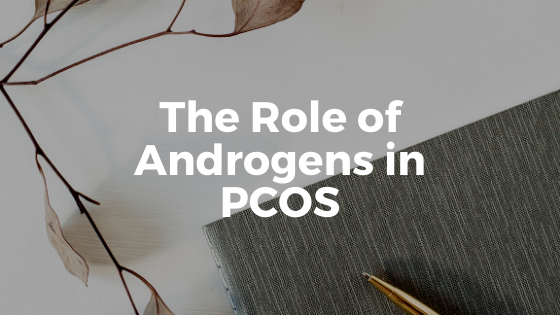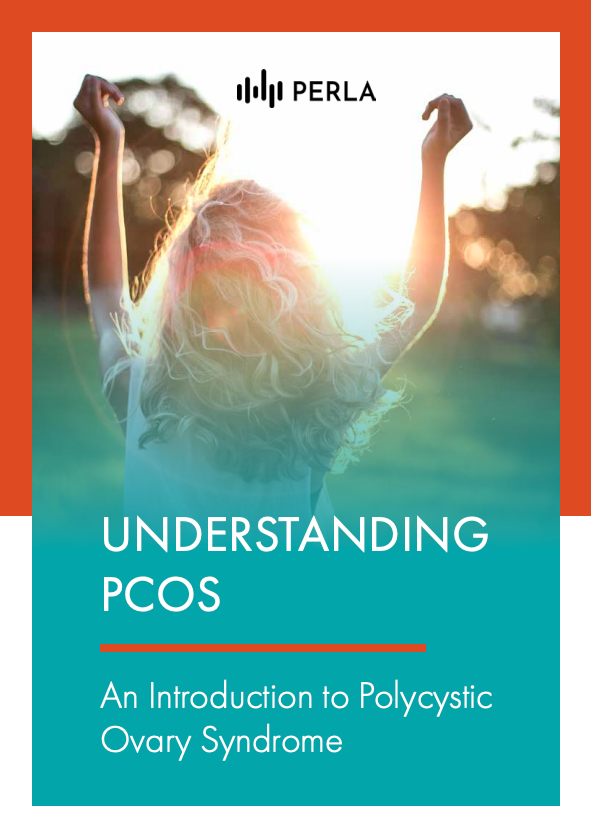Hyperandrogenism, the medical term for having excess levels of androgens, can cause changes in the female body such as male pattern hair growth, acne or hair loss. Elevated androgens is one of the key criteria for diagnosing PCOS (Polycystic Ovary Syndrome). If left untreated, PCOS can increase your risk for serious medical conditions, including obesity, infertility, hypertension, diabetes, and dyslipidemia. But what should you know about androgens? Let’s dive in:
What are Androgens?
Androgens are commonly referred to as “male hormones,” but don’t let the name confuse you. Both men and women produce androgens, though not in the same amounts. For example, the circulating testosterone in women is usually only 10% of that in men.1 Women need a small amount of androgen to produce the female sex hormones called estrogens.
Androgens are a group of sex hormones that give men their male characteristics—deepening of voice, the growth of facial and body hair, Adam’s apple, increased muscle mass, and penile growth—collectively called virilization. Androgen hormones are made primarily in the male testicles, female ovaries, and adrenal glands. An excessive production of androgens in the ovaries and adrenals can lead to hyperandrogenism.
Measurement of Androgens in PCOS2
To understand if you have hyperandrogenism, your doctor may measure the levels of hormones in your blood, such as:
- Free Testosterone: Testosterone is one of the most well known androgens. It exists in two forms, free (active) testosterone and bound (inactive) testosterone. Approximately two-thirds of testosterone in the blood is bound to the protein sex hormone-binding globulin (SHBG) and less than one-third is bound to albumin. Less than 4% is unbound and active in the body.
- Total Testosterone: Total testosterone refers to the amount of bound (inactive) and free (active) testosterone.
- Dehydroepiandrosterone sulfate (DHEAS): Mainly produced by the adrenal glands and in small amounts by the ovaries. DHEAS can be converted to estrogen and the more potent androgens testosterone and androstenedione.
- Androstenedione: Women with PCOS may also have elevated levels of this hormone.
What is Hyperandrogenism?
In diagnosing PCOS using the Rotterdam criteria, a woman must have two out of the following three symptoms:3
- Clinical or biochemical hyperandrogenism (excess levels of androgens)
- Irregular periods or no periods
- Polycystic ovaries on an ultrasound
Note that there are two different ways on how to see if there are excess levels of androgens present:
Clinical hyperandrogenism: These are visible signs or symptoms that high levels of male sex hormones are circulating in the blood. These include hirsutism (excess hair growth), acne, male pattern baldness, and virilization. If you are experiencing any of these symptoms, consult your doctor or primary care provider.
Biochemical hyperandrogenism: Your lab results show high levels of androgen hormones in the blood. Excess androgen can be tested by measuring free testosterone and total testosterone or a free androgen index.4 When the free testosterone level is high, it is a sensitive indicator of hyperandrogenism.
Clinical Signs of Hyperandrogenism in PCOS
The most common clinical signs of hyperandrogenism are:
Hirsutism
Hirsutism is the medical term for male-like hair growth in women, affecting 70-80% of women with PCOS.5 It is characterized by excess growth of coarse and dark hair in areas where it normally wouldn’t grow, such as the face, chin, chest and back. Many women remove this abnormal hair growth without realizing that it can be a symptom of an underlying hormonal condition.
Androgens stimulate hair growth in certain areas of the body that are sensitive to sex hormones.6 These androgen-sensitive areas include:
- Upper lip
- Sides of the face
- Chin
- Chest (around the nipples)
- Back
- Abdomen
- Inner thighs
- Pubic region
Areas that are less sensitive to androgens:
- Arms
- Lower legs
Hairiness and hirsutism are not the same. Hair density and distribution can vary according to ethnic groups: Women in the Mediterranean, Middle East, and Indian subcontinents may show some degree of hairiness, which is not associated with PCOS or other androgen-related disorders.7
In addition to your primary care provider, you may need an endocrinologist to assess if your hirsutism is caused by a hormonal (endocrine) problem.
Acne
Excess testosterone in the body increases oil secretion and skin cell production, leading to the formation of comedones and cystic acne in the forehead, around the mouth, and jawline areas. Because acne is common in the general population, other signs and symptoms should be considered to determine if there is androgen excess.
Male Pattern Hair Loss
Hair thinning that occurs either on the crown of the head or the hairline can be a sign of clinical hyperandrogenism.8 In female pattern baldness, the hair usually thins out on the top of the head, without a hairline recession.
Other signs of female virilization, such as voice deepening, increased muscle growth, loss of feminine body contour, and clitoromegaly (enlargement of the clitoris), are not commonly seen in PCOS, but can be important symptoms of other conditions. If you experience these signs, make sure to also mention them to your primary care provider.
Health Conditions Caused by Excess Androgens
Aside from causing irregular cycles, infertility, and distressing symptoms like hirsutism and acne, increased androgen levels are also linked to some of the medical conditions that often occur in PCOS.
Insulin Resistance
Women with elevated androgen levels tend to be at a higher risk of insulin resistance. Managing high levels of testosterone in these women also improves insulin resistance.9
Obesity
Although obesity is a risk factor for PCOS, women with normal weight may also develop PCOS. Excess androgen seems to play a role in storing body fat in the abdominal region.
Heart Problems
High testosterone and low estrogen increase your chance of getting cardiovascular complications. Maintaining a healthy weight through diet and exercise reduces your risk.
Conclusion
Androgens, or so-called “male hormones”, are the key culprit in PCOS. If you experience signs of excess levels of androgens (hyperandrogenism) such as male pattern hair growth (hirsutism), acne or hair loss, make sure to mention it to your doctor or primary care provider, as they can look into it and see which treatment options you have.
Sources:
- The Editors of Encyclopaedia Britannica. Androgen | hormone | Britannica. In: Encyclopædia Britannica. ; 2014. https://www.britannica.com/science/androgen
- Richardson MR. Current Perspectives in Polycystic Ovary Syndrome. American Family Physician. 2013;68(4):697-704. https://www.aafp.org/afp/2003/0815/p697.html
- Williams T, Rami Mortada, Porter S. Diagnosis and Treatment of Polycystic Ovary Syndrome. American Family Physician. 2016;94(2):106-113. https://www.aafp.org/afp/2016/0715/p106.html
- Ashraf S, Nabi M, Rasool S ul A, Rashid F, Amin S. Hyperandrogenism in polycystic ovarian syndrome and role of CYP gene variants: a review. Egyptian Journal of Medical Human Genetics. 2019;20(1). doi:10.1186/s43042-019-0031-4
- Yildiz BO, Bolour S, Woods K, Moore A, Azziz R. Visually scoring hirsutism. Hum Reprod Update. 2010;16(1):51–64. doi:10.1093/humupd/dmp024
- Monash University. Excess body hair-hirsutism – causes and treatment option advice for health professionals. Public Health and Preventive Medicine. Published February 2020. Accessed January 7, 2021. https://www.monash.edu/medicine/sphpm/units/womenshealth/info-4-health-practitioners/hirsutism
- Hirsutism (Excessive Hair) – Women. Vic.gov.au. Published April 2018. Accessed January 7, 2021. https://www.betterhealth.vic.gov.au/health/ConditionsAndTreatments/hirsutism-excessive-hair-women
- Shum KW, Cullen DR, Messenger AG. Hair loss in women with hyperandrogenism: four cases responding to finasteride. J Am Acad Dermatol. 2002;47(5):733-9.
- Corbould A. Effects of androgens on insulin action in women: is androgen excess a component of female metabolic syndrome?. Diabetes Metab Res Rev. 2008;24(7):520-32.


